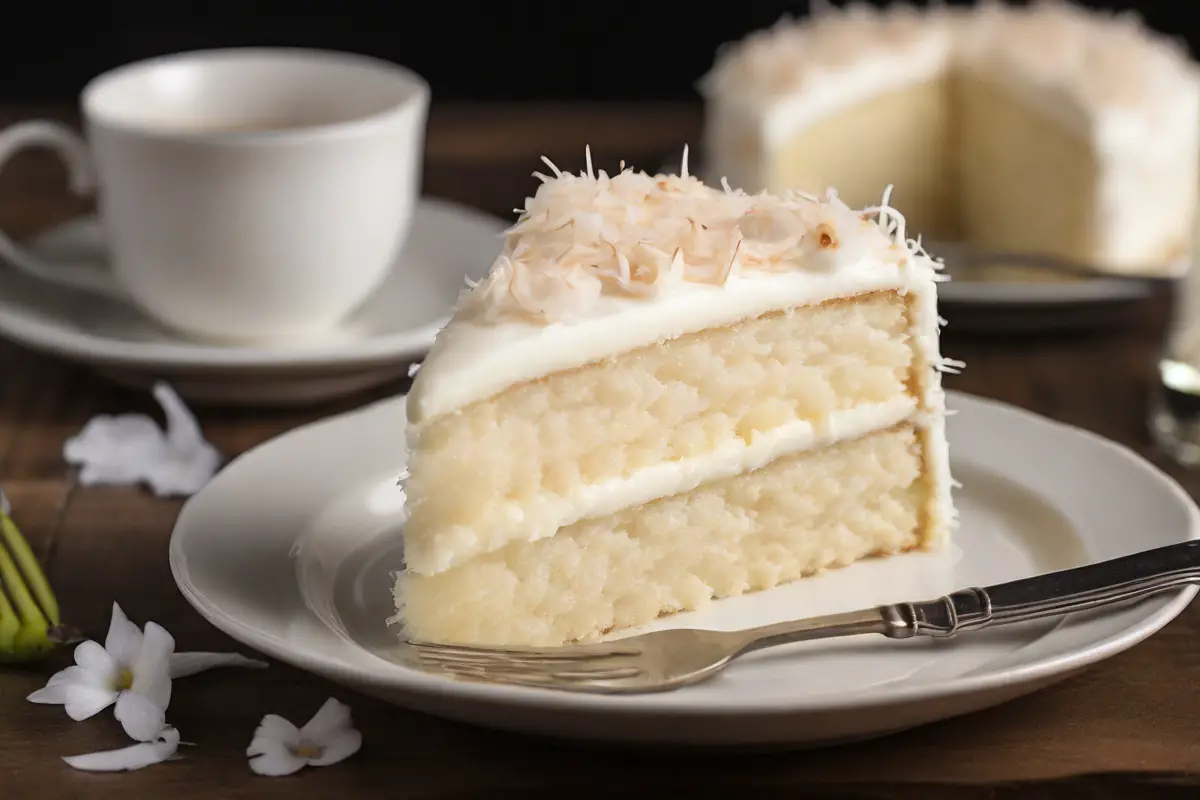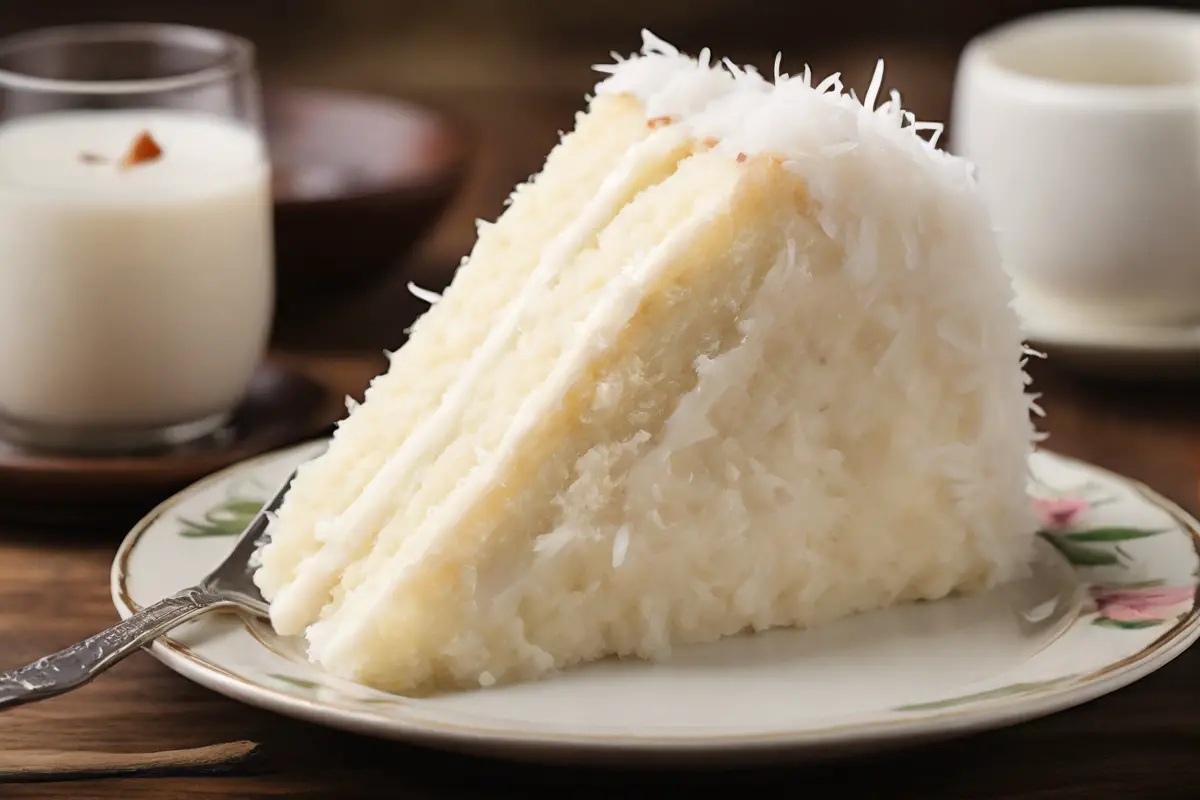Introduction to Coconut Cake Recipe
Welcome to the delightful journey of baking a Coconut Cake, a dessert that perfectly captures the essence of tropical bliss. This article is a comprehensive guide to creating a coconut cake that’s not only visually stunning but also bursting with the rich, sweet flavor of coconut. Whether you’re a seasoned baker or new to the world of baking, this guide will walk you through each step, from selecting the right ingredients to the final touches of frosting. So, let’s embark on this culinary adventure and bring a slice of tropical paradise to your kitchen!
The Charm of Coconut Cake
Coconut cake is a beloved dessert known for its moist, fluffy texture and rich coconut flavor. It’s a versatile cake that can be dressed up for special occasions or enjoyed as a simple, comforting treat. The unique taste of coconut, combined with a light, airy cake, makes it a favorite among dessert lovers.
History and Popularity
The popularity of coconut cake can be traced back to the tropical regions where coconuts are abundant. Over time, it has become a staple in many cultures, celebrated for its delightful flavor and the way it brings a taste of the tropics to any occasion. Its enduring appeal lies in its ability to adapt to various styles and flavors, making it a timeless classic in the world of desserts.
In the next part, we’ll explore the process of selecting the best ingredients for your coconut cake, ensuring a perfect start to your baking experience.
For more insights on the different types of coconut products and their uses in baking, check out Mastering Coconut Flavors in Baking. Understanding your ingredients is crucial for baking success.
Choosing Ingredients
Types of Coconut Products
When it comes to baking a coconut cake, the type of coconut product you use can significantly impact the flavor and texture. Shredded coconut, coconut milk, and coconut cream are the most commonly used forms. Shredded coconut adds texture and chewiness, while coconut milk and cream infuse the cake with a rich, creamy flavor. Opt for unsweetened varieties to control the sweetness level of your cake.
Essential Ingredients for Coconut Cake
Apart from coconut products, other essential ingredients include all-purpose flour, sugar, baking powder, eggs, and butter. These ingredients form the base of your cake, providing structure and richness. For an extra coconutty flavor, consider using coconut oil instead of butter and adding a splash of coconut extract.
In the next part, we’ll delve into the art of preparing the perfect coconut cake batter, focusing on achieving the right balance of flavors and textures.

Crafting the Perfect Batter
Mixing Techniques
The key to a perfect coconut cake batter lies in the mixing technique. Start by creaming the butter and sugar together until the mixture is light and fluffy. This process introduces air into the batter, making the cake light. Next, add the eggs one at a time, ensuring each is fully incorporated before adding the next. This step is crucial for a smooth, homogenous batter.
Achieving the Right Consistency
Once the wet ingredients are well-mixed, gently fold in the dry ingredients – flour, baking powder, and a pinch of salt. Be careful not to overmix, as this can lead to a dense cake. Alternate the dry ingredients with coconut milk, beginning and ending with the dry mixture. This method helps to maintain a balanced moisture level in the batter, resulting in a tender, moist coconut cake.
In the next part, we’ll explore the baking process, focusing on oven preparation and techniques to ensure your coconut cake is baked to perfection.
Baking the Cake
Oven Preparation and Temperature Settings
Proper oven preparation is crucial for baking a flawless coconut cake. Preheat your oven to the recommended temperature, usually around 350°F (175°C). This ensures a consistent baking environment right from the start. Use an oven thermometer to verify the temperature, as oven dials can sometimes be inaccurate.
Testing for Doneness
Evenly distribute the batter into prepared cake pans, smoothing the tops with a spatula. Bake until the cake is golden brown and a toothpick inserted into the center comes out clean. The edges should start to pull away from the sides of the pan. Remember, baking times may vary based on your oven and the size of your cake pans, so keep a close eye on your cake as it bakes.
In the next part, we’ll delve into the world of frostings and decorations, adding that extra touch of sweetness and elegance to your coconut cake.
For more baking insights and how to achieve the perfect bake every time, check out Baking Perfect Cakes. It’s an excellent resource for understanding the science behind cake baking.

Frosting and Decoration
Cream Cheese Frosting Options
A classic choice for coconut cake is cream cheese frosting. Its tangy flavor complements the sweet, tropical taste of the cake. To make it, blend cream cheese with butter, powdered sugar, and a hint of vanilla extract until smooth. For an extra coconut touch, mix in a bit of coconut cream or shredded coconut into the frosting.
Creative Decoration Ideas
Once your cake is frosted, it’s time to get creative with decorations. Toasted coconut flakes sprinkled on top add a delightful crunch and enhance the coconut flavor. Edible flowers or fruit slices can add a pop of color, while a drizzle of caramel or chocolate sauce can bring in an additional layer of sweetness. Remember, the decoration should not only be beautiful but also complement the flavors of the cake.
In the next part, we’ll discuss serving suggestions and storage tips to ensure your coconut cake is enjoyed at its best.
For more frosting recipes and creative decoration ideas, explore Innovative Cake Decorating Ideas. It’s a fantastic resource for finding the perfect finishing touches for your cake.
Serving and Storage
Presentation Tips
Serving your coconut cake is as much about presentation as it is about taste. For a truly elegant display, use a cake stand and garnish with fresh tropical fruits like pineapple or mango slices. If serving at a gathering, consider individual plating, adding a dollop of whipped cream or a drizzle of coconut syrup for an extra touch of luxury.
Pairing with Beverages and Desserts
Coconut cake pairs beautifully with a variety of beverages and desserts. A cup of strong coffee or a glass of dessert wine complements the rich flavors of the cake. For a dessert pairing, consider something with a contrasting texture, like a creamy custard or a fruit sorbet.
Storing Cookies for Freshness
Proper storage is essential to maintain the freshness of your coconut cake. Keep it in an airtight container at room temperature if it’s unfrosted or in the refrigerator if it’s frosted. The cake will stay fresh for several days. For longer storage, you can freeze individual slices, well-wrapped, for up to a month.
In the next part, we’ll delve into the nutritional benefits of coconut cake and how to enjoy it as part of a balanced diet.

Nutritional Information
Caloric and Nutritional Content
While indulging in a slice of coconut cake is a delightful experience, it’s important to be aware of its nutritional profile. Coconut, the key ingredient, is rich in fiber and essential minerals like manganese and copper. However, the cake also contains sugar, butter, and flour, which contribute to its overall calorie count. Moderation is key when enjoying this dessert, especially if you’re mindful of your calorie intake.
Making Healthier Choices
For those looking to enjoy coconut cake with a healthier twist, there are several adjustments you can make. Substitute part of the all-purpose flour with whole wheat flour to increase fiber content. Use reduced-fat coconut milk and a sugar substitute to lower the calorie count. Additionally, incorporating fruits like berries can add natural sweetness and nutritional value.
In the next part, we’ll answer some frequently asked questions about coconut cake, providing additional tips and insights.
For detailed nutritional information on various ingredients used in baking, such as coconut, flour, and sugar, visit Nutritional Information Database. It’s an excellent tool for those who want to bake with health in mind.
Common Queries and Tips
Q1: Can I make coconut cake without eggs?
Yes, you can make an eggless coconut cake by using substitutes like applesauce, mashed bananas, or commercial egg replacers. These alternatives help to bind the ingredients together, similar to eggs.
Q2: How can I make my coconut cake more moist?
To ensure your coconut cake is moist, avoid overbaking it. Using ingredients like coconut milk and oil also helps to add moisture. Additionally, you can brush the baked layers with simple syrup before frosting.
Q3: What are some vegan frosting options for coconut cake?
For a vegan frosting, you can use plant-based cream cheese and butter alternatives. Coconut cream can also be whipped into a light, fluffy frosting suitable for vegan diets.
Q4: Can coconut cake be made in advance?
Yes, coconut cake can be made in advance. You can bake the cake layers and store them in the refrigerator for a couple of days or freeze them for longer storage. Frost and assemble the cake when you’re ready to serve.
Q5: Are there any nut-free alternatives for decorating coconut cake?
For a nut-free decoration, consider using shredded coconut, edible flowers, or fruit slices. You can also use sprinkles or non-nut-based edible decorations.
In the next part, we’ll share some advanced baking tips and variations for making coconut cake, offering ways to add a creative twist to this classic treat.
Advanced Baking Tips
Experimenting with Flavors
For those looking to add a unique twist to their coconut cake, experimenting with different flavors can be quite exciting. Consider infusing your cake with citrus zest, such as lime or orange, for a tropical flair. Spices like cardamom or a hint of rum can also add depth to the coconut flavor. Incorporating these elements into either the batter or the frosting can create a delightful variation on the classic coconut cake.
Advanced Decorating Techniques
If you’re keen on presentation, try your hand at more advanced decorating techniques. Fondant can be used to create elegant designs, or you can try piping intricate patterns with buttercream. For a more rustic look, a naked cake style with minimal frosting on the outside showcases the cake layers and filling beautifully. Edible gold leaf or pearl dust can add a touch of sophistication to your decoration.
In the conclusion, we’ll wrap up our comprehensive guide on making coconut cake. Get ready to impress your family and friends with your new baking skills!
Conclusion
As we conclude our exploration into the art of baking a coconut cake, it’s clear that this delightful dessert is more than just a treat; it’s a canvas for culinary creativity. From selecting the finest ingredients to mastering the bake and exploring innovative decorating techniques, each step in creating a coconut cake is an opportunity to express your passion for baking.
Remember, the beauty of baking lies in the joy it brings, both in the making and the sharing. Whether you’re celebrating a special occasion or simply enjoying a quiet moment with a slice of cake, the warmth and richness of a coconut cake are sure to bring a smile. So, gather your ingredients, preheat your oven, and embark on the delightful journey of baking a coconut cake. Happy baking!
After mastering the art of coconut cake, why not expand your baking repertoire with our Lemon Blueberry Cheesecake? Its vibrant flavors and creamy texture make it a perfect complement to the tropical notes of your coconut creation
Looking for a savory dish to balance your sweet baking adventures? Dive into our Vesuvio Potatoes recipe, a culinary journey that pairs wonderfully with the tropical theme of cake. These perfectly seasoned potatoes make an excellent side dish for any meal and are a great way to explore diverse tastes in your cooking

